Planet Dinosaur – Fight For Life
Kimmerosaurus, Plesiosaur, Stegosaurus & Camptosaurus
This time we journey back 150 million years to the Jurassic Period, a time
when when the first giant killers stalked The Earth. But the giants weren’t
confined to the land.
Recent discoveries have revealed astonishing new hunter in the
oceans. These new giant killers pose the greatest of threats, with thr smallest
advantage tipping the balance between life and death. Predator and prey
were locked in a perpetual battle for survival.
The Jurassic Period was a time when much of Europe looked like The
Bahamas. A time when the warm tropical seas were home to giant
predators, some of which have left their mark etched in stone.
A cliff-face in Switzerland is carved with an enormous system of gouges
and grooves, many over 9m long. The entire rock-face is actually one
huge fossil, an upturned slab of Jurassic ocean floor. The marks were
left by a predator as it hunted for food.
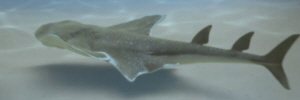
Squatina
Sharks, like the Squatina are similar to Angel Sharks which still
exist today. Its an ambush predator that lies in wait buried in the
sand. But, in these seas there are bigger hunters. Kimmerosaurus, of the
Plesiosaur group, at 6m long are one of the Jurassic oceans most
successful hunters and one of the most common.
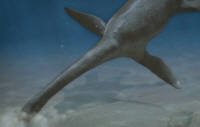
Kimmerosaurus
Its unusual hunting method, furrowing the sand looking for hidden
Squatina, left its trace on the ocean floor. We now know that the
rock-face in Switzerland is etched with the marks of hunting
Plesiosaurs. But, these giants were not king of the seas. Many of the
fossils show evidence of being violently ripped apart. Clearly, there
were much bigger predators lurking in these seas.
In 2008, on an island in the high Arctic, a fossil was dug out of the
frozen earth. Its skull alone was nearly twice the size of that of a T.
Rex. This was an enormous killer. A killer the like of which had never
been seen before. More than 15m long and weighing about 45 tons, this is
the most powerful marine reptile discovered.
Twice as big as most Jurassic ocean predators – this is Predator X,
an animal that must go down in history as one of the ocean’s most deadly
hunters and i is prey like Kimmerosaurus that are in its sights.
Skull analysis of giant killers like Predator X suggest they hunted
their prey by smell. Channelling water through special internal nostrils
allowing then to silently hone in on their targets.
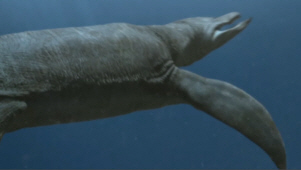
Predator X
By analysing their anatomy, they calculated that Predator X could
move at up to 5m/s, fractionally faster than Kimmerosaurus. The
Kimmerosuarus’ only defence is to head for the refuge of shallow water.
The inability of Predator X to hunt efficiently in shallow water means
that Kimmerosaurus can use this as a refuge. A subtle advantage that
makes the difference between life or death.
Predator X and Kimmerosaurus are just one example of a predator /
prey relationship locked in a fight for survival.
The western states of North America are one of the richest sources of
dinosaur fossils. Its known as the Morrison Formation. Recently, these
rocks have given us a tantalising glimpse of two dinosaurs adapted
together to protect themselves – Stegosaurus and Camptosaurus.
Fossils of these two species are almost always found in the same area. In
2008, footprints of the two were recovered from the same site. It seemed they
lived alongside one another. But, why would two unrelated plant-eaters live
together?
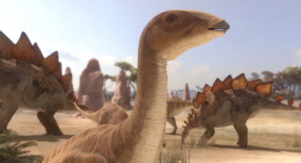
Camptosaurus with Stegosaurus
Stegosaurus: a heavily armoured tank with a deadly weapon, known as a
thagomizer, at the end of its tail. Camptosaurus: a much smaller
plant-eater with no obvious defences.
Skull analysis shows that Camptosaurus had bigger eyes and, relative to
its bosy, a much bigger brain. Camptosaurus appears to be a lookout while the
armoured Stegosaurus provides the muscle. Its likely that Camptosaurus and
Stegosaurus stuck close together for mutual protection in a world where
danger is ever present.
Allosaurus is a one and a half ton ambush hunter with a lethal bite,
the world had never known a predator like it. Having missed an attack on
Camptosaurus, Allosaurus is face with starvation or facing the most well
protected giant of the Jurassic. Virtually impregnable from behind, a
predator needs to try to attack Stegosaurus from the front. The
Allosaurus takes a blow from a thagomizer and is beaten.
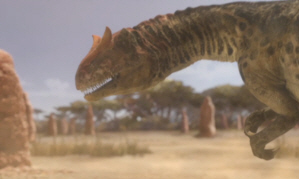
Allosaurus
The evidence of encounters such as these is incredible. Fossil finds
of 2005 directly link these two great animals in battle, revealing the
unmistakable signs of injury. A Stegosaurus backplate was discovered
with a ‘U’ shaped bite taken out of it. A bite mark that fitted the
Allosaurus jaw perfectly. Even more amazing was an Allosaurus vertebra
with a massive impact wound. The wound appeared to have been made by a
Stegosaurus thagomizer. The blow being so powerful it punched a hole in
the bone of the Allosaurus spine.
The balance of power between predator and prey is a fine one. Prey continually
evolves different strategies to avoid predators.
Allosaurus is the most common killer in these lands. At 9m long with a
battery of saw-blade like teeth and powerful clawed forearms, Allosaurus is a
formidable hunter.
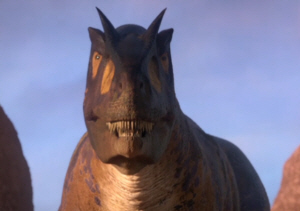
Saurophaganax
Allosaurus teeth were serrated front and back, perfectly evolved for
tearing through flesh. However, recent research has indicated that
Allosaurus bite was surprisingly weak. Calculation has suggested its bite
was less powerful than a lopn, despite being 7 times more massive. So, just
how did this Jueassic monster hunt and kill? The answer is with an element
of surprise.
Camptosaurus relies on its keen senses to avoid predators.
Allosaurus, on the other hand, is a fast and powerful ambush hunrer,
faster than Camptosaurus. But, a one and a half ton killer can’t run
fast for long. Its a question of speed versus stamina.
Despite the apparent weaknes of the bite, Allosaurus did, in fact,
have a deadly killing method. Its skull could withstand a force more
than 15 times as great as its bite. This meant that Allosaurus used its
head like a axe, strong neck muscles driving its top jaw into its prey.
With every impact, the serrated teeth would tear through the prey’s
flesh. The victim dying through a combination of shock and blood-loss.
It isn’t pretty, it isn’t clinical, but it was ruthlessly efficient.
However, making a kill is no guarantee of getting a meal. Allosaurus
isn’t the only killer in these parts. Saurophaganax, at 12m is the
biggest carnivore in the region and one of the advantages of being so
big is that stealing another’s kill is that much easier.





